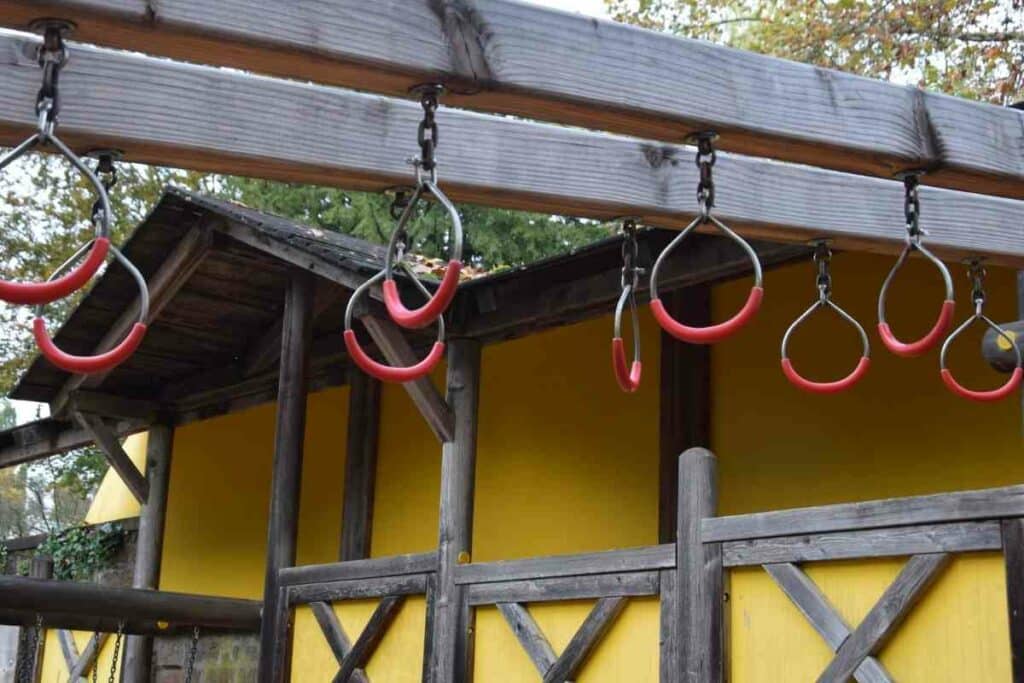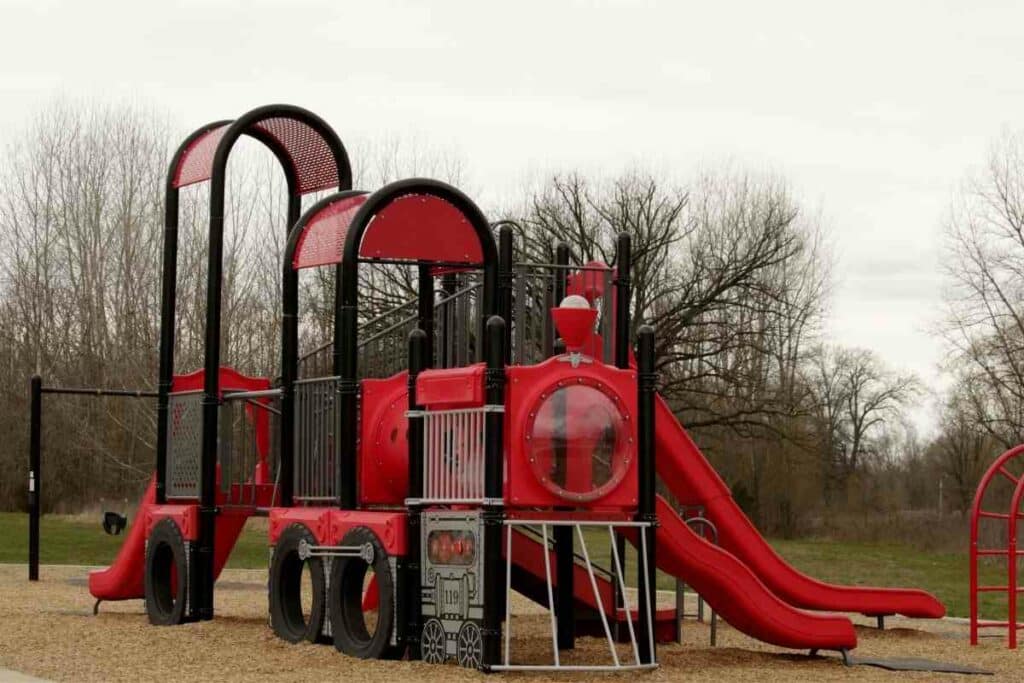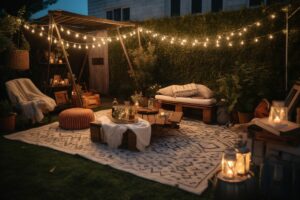A generation or two ago, when there was very little in the way of video games and many of the trappings of kids’ entertainment nowadays just hadn’t been thought of, good old-fashioned backyard fun and games were in the form of a jungle gym.
As we try to navigate the balance between YouTube, Netflix, and gaming, it’s important to show the current generation of youngsters how to have fun in a more traditional (and physical) way.
Meet the jungle gym!
In this article, we’ll talk you through how to make a DIY jungle gym in your own backyard. Let’s go!
What is a jungle gym?
Imagine a monkey in the jungle climbing and swinging, that’s pretty much what a jungle gym allows kids to do.
Essentially, it’s a structure of vertical beams and horizontal bars and parts with different attachments that lots of kids can use at the same time.
Rather than a stand-alone climbing structure or swing set, it incorporates lots of fun elements all in one structure.
Help with making a DIY Jungle Gym

There are lots of designs out there and it would be impossible to talk about them all in one place.
The only thing that limits you when making a DIY jungle gym is your imagination.
Here are some tips on what you might want to consider:
Tip #1: Be creative
All you need is a little bit of imagination and you can create something really unique.
The jungle gyms being sold on the shelves today were all once the idea of someone who sat down with a pen and paper.
Tip #2: Think about what your kids like
All kids are different and have different likes and dislikes.
If your kids are really into pirates, you could design something that reflects their interests.
If they love monkey bars, you’d be silly not to incorporate a set into their own jungle gym.
Also, consider things like how many friends might come and play on it and how quickly will they grow out of it?
Don’t Forget – You can (and should) ask your kids what they’d like. Be prepared for them to come up with elaborate designs, though!
Tip #3: Think about how much space you’ve got
Your available space for the project will largely determine what sort of design you choose.

If you want a slide, remember you’ll need landing space and so the footprint of your design will need to be considerably smaller than the available space.
Tip #4: Think about your budget
It’s all good and well coming up with a huge, elaborate, jungle gym design but if you run out of money halfway through, it will be unusable.
You need to budget carefully – and it’s a good idea to buy all of the materials up front.
Things you can include in your design
If you’re not at the designing stage and don’t know what to incorporate into the structure, here are some ideas to get you started.
A swing
Swings are one of those things that you don’t really grow out of.
I’ve known many an adult sit on a swing in someone’s backyard and have a great time!
As well as being fun, swings are great for core strength and abdominal muscles.
Having good core strength is important as it helps you support yourself when walking, balancing, running, and playing sports.
Swinging is also great for developing coordination.
Once you stop relying on another person to push you and learn how to move the swing by yourself, you’re really working hard on your coordination.
In Essence – Swinging can be a full-body workout for kids!
Monkey bars
These are a classic addition to jungle gyms and kids love them.

Monkey bars are amazing for upper-body strength as well as core strength.
They’re so versatile too.
Kids love seeing if they can turn on them, miss a rung, or even hang upside down from them.
Monkey bars are so versatile – and even adults can have fun on them too!
A climbing slope or wall
The great thing about climbing walls in jungle gyms is that you can change it when your kids have got used to it.
If your kids are younger, you can include lots of holds, but as they age you can move them and reduce the number.
Climbing walls are great for encouraging core strength, leg strength, and finger strength.
A fireman pole
A fireman pole is a great addition to any jungle gym and encourages youngsters to face the fear of taking the leap.
Because they’re so fun, kids will want to go down and down again, which encourages lots of climbing.
Even Better – Older kids often like to see if they can scale up the pole too, which is fantastic for whole-body strength.
Rope ladders
Rope ladders provide a way to get onto the jungle gym while improving their core strength and balance.
The instability of a rope ladder is also great fun as children try to maintain their stability until they reach the top.
Slide
Slides are seen as an important part of a jungle gym.
Along with the fireman pole, they’re often the whole point of getting onto the structure in the first place.
It’s truly crazy how many times a child will climb up the jungle gym to use the slide!
Older kids will often try to scale the slide too, which makes it even more versatile.
How to make your own jungle gym step-by-step

If you’ve now got more of an idea of what jungle gyms are and what you want, here are some steps you’ll need to go through before it’s complete.
Remember, because all your designs will be different, this is a generic step-by-step process.
Let’s start!
1: Measure your space
The equipment and features we’ve mentioned above will only work if you’ve got enough space to put them in your design.
Start by marking out the area you intend to build your jungle gym.
Many people advise leaving three feet of space on each side of the frame so that the kids can run around and access the structure easily.
If you don’t have a lot of space, consider building a higher jungle gym so you can still incorporate lots of fun elements with your smaller footprint.
2: Choose your components and design
With the space measured, try to come up with a design that will fit.

Browse designs of a similar size online.
Here are a few points to consider.
Shelter
Have a place in your jungle gym where your kids can take shelter from the sun, rain or wind and still have fun.
The shelter could be three-sided with a roof, or it could just be somewhere underneath the main structure, maybe with a small bench to sit on.
The shelter could also be at the top of the slide.
Alternatively – The shelter could be at the ground level and contain a sandpit.
Use appropriate materials
If you’re spending a lot of money making a jungle gym, you need to ensure it will be made to last.
Using weatherproof materials like treated wood, galvanized rivets, outdoor fabric and PVC will ensure that it won’t be unusable in a few years’ time.
Add in extra elements where you can
As well as designing the whole structure, think about where you could add:
- a swing
- a net
- a rope ladder
- some hoops
- or monkey bars
These can often be incorporated on the sides or underneath parts of a structure.
Consider elements that stimulate the mind
Could you add a chalkboard surface for a mark-making wall?
Or a game of tic-tac-toe?
Even adding in things that spin or make noise or music will be quite simple to do.
3: Materials and construction

For most types of DIY jungle gym, you’ll need:
- Deck boards
- Pressure-treated lumber
- Galvanized wood screws
- Galvanized metal wood brackets
- Galvanized swing frame brackets
- Saws (hand or table saw)
- Power drill
- A slide
- A swing seat
- Posts
- Concrete
The first part of making the jungle gym is to set the posts.
These should be set at least three feet into the ground.
If your DIY jungle gym is wooden, you should put the wooden posts into metal posts before casting them in concrete.
This is to ensure the wood lasts longer and won’t rot.
Concrete will need at least 24 hours to cure.
The rest of the construction will depend on your chosen design.
When Building – It’s a good rule of thumb to keep consulting your plans and don’t just go in ad-hoc (as this will likely lead to problems).
With the frame built, the final touches to the structure will be things like adding the rope ladder and swing or adding the holds for your climbing wall.
If you have used treated lumber, it won’t need painting – unless you choose to paint it.
How to make a DIY jungle gym in your backyard – FAQs

Who created the first jungle gym?
The first marketed jungle gym was created in Chicago in 1920 by Sebastian Hinton who was a lawyer.
It was patented and trademarked as JunglegymTM.
The second of Hinton’s jungle gyms was in Winnetka at Crow Island School, where it stayed until 2010.
Now, this jungle gym is displayed in the backyard of the Winnetka Historical Museum.
Where was the first-ever children’s playground built?
It’s believed that the first-ever purposely built children’s playground appeared in a park in Manchester, England in 1859.
In the U.S., it was President Theodore Roosevelt that introduced the concept officially in 1907.
However, there were some in existence already before they were officially introduced.
What muscle groups do monkey bars help to build?
Monkey bars are great for building upper body strength.
They work on the deltoid (shoulder) muscles, the “lats” (latissimus dorsi) muscles, the obliques, the abdominal muscles, and the biceps.
They’re also excellent at building up grip strength as they strengthen hand muscles as you grab the bars.
What are the most popular things to include on a DIY jungle gym?
Here are some things that kids most enjoy on jungle gyms:
- Slides (it doesn’t matter if it’s a straightforward slide, spiral slide or tunnel slide, they’re loved by all)
- Swings (this is a classic that even adults will admit to still enjoying!)
- Roundabouts or merry-go-rounds (these are much harder to put into DIY jungle gyms!)
- See-saws or teeter-totters (read this article to see what the difference is between the two)
- Things to climb (rope ladders, climbing walls, ladders)
- Fireman pole
What are the alternatives if you don’t have space for a jungle gym?
If you have a small backyard and don’t have space for a large jungle gym structure, there’s no reason why you can’t incorporate many of the jungle gym elements into your backyard separately.
A climbing wall is a great addition to any wall or strong fence, a rope swing can be attached to a tree branch, a stand-alone slide can be put in a small space.
The opportunities are endless.
If you want further inspiration, take a look at natural backyard playgrounds as these tend not to have huge DIY jungle gym structures but are just as creative and interesting for your little ones to enjoy.
Final thoughts on making a DIY jungle gym in your backyard
If you’ve decided to create a DIY jungle gym, it can be a really satisfying project.
Remember, as will most large DIY projects, there will be times when you feel as though you’ve taken on too much or that you’ll never finish!
When this happens, take a step back and ask for someone else to help and give advice.
Seeing your kids enjoy their finished jungle gym is truly worth the hard graft! Good luck!






